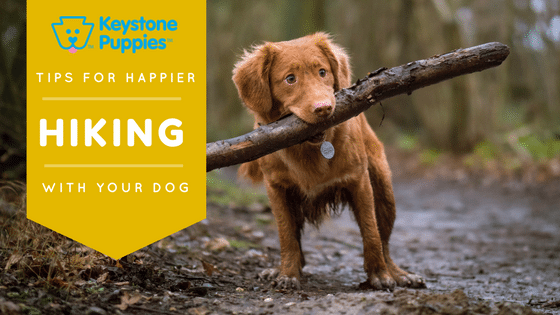Happier Hiking With Your Dog

Every dog loves a good walk, and we’ll let you in on a little secret about hiking: it’s just a more interesting way to take walks. Whether you’re exploring pathways in your local park or venturing onto nature trails, hikes are a great way to tire out pups. The additional exercise can also help curb boredom-based behaviors like chewing, digging, or excessive barking. As a rule, a tired dog is a well-behaved dog.
If you’d like to try hiking with your pup, there are a few important considerations to keep in mind.
Is Your Breed Suited for Strenuous Hiking?

Before you set off on a mountain trail, take time to evaluate your dog’s temperament and physical limitations. Many breeds have attributes that are well-suited to hiking, including Labrador Retrievers, Siberian Huskies, Alaskan Malamutes, Portuguese Water Dogs, Australian Shepherds, Bernese Mountain Dogs, Border Collies, and Weimaraners.
Conversely, breeds with short snouts, like Pekingese, Pugs, Puggles, Boxers, American Bullies, Pit Bull Terriers, and Boston Terriers, will have a difficult time regulating their breath in warmer climates, especially if the walk is long or if the trail is upward.
No matter which breed you have, if your pup is overweight or out of shape, you should start out slow. Starting slow is also good advice for owners of very young dogs or very old dogs. Never take a puppy younger than 14 weeks on nature hikes. If your dog is ill, leave him at home. And it’s always a smart idea to check with your veterinarian to determine your dog’s limitations.
Which Kind of Trail is Best for Your Dog?
If you haven’t hiked with your pup before, you might want to start with short hikes in cool weather over flat terrains. Look for trails that are easy on your dog’s paws, and that offer plenty of shade. Soft earth paths through leafy forests are easy for dogs to walk on, while rocky trails in full sun may lead to heat exhaustion. Start slow, and work your way up to bigger challenges, using your dog’s ability and breed traits as a guide.
Experienced dog hikers may want to try trails with some physical challenges, like hills, stream crossings, suspension bridges, or steep inclines. But remember to take it slow. While you may want to tire your dog, you don’t want him to slip, pull a muscle, overheat, dehydrate, or otherwise injure himself.
Make Sure the Trail Allows Dogs
Many trails prohibit dogs. Not all national and state trails allow pets, and the rules for city or county nature areas vary widely. Even if the trail allows dogs, they may require a leash of 6 feet or less. If the trail has a website, check it out before leaving home. There are many websites that list dog-friendly trails or review the trails for dog owners. BringFido.com lists dog-friendly trails around the world. HikeWithYourDog.com helps you find dog-friendly trails in the U.S. and Canada.
What to Pack for a Dog Hike
Food and Water
Many nature hikes can last for hours. Bring your dog treats or snacks with you to help your pooch stay energized. Bring a portable water dish or a water bottle for your pup and give him sips frequently. Don’t let your dog drink from streams or lakes, since they may contain harmful bacteria or parasites. Watch out for excessive panting, drooling, or a lack of coordination as a sign of heat exhaustion or dehydration. If your dog shows these symptoms, get him to a cool, shady spot, let him rest completely, and keep giving him short drinks of water.
First Aid
If you’re hiking very far away from easy transportation or cell tower signals, it’s smart to pack a simple first aid kit that includes:
- Styptic swabs to help stop bleeding for small cuts
- Rubber gloves or dog booties to help dogs continue to walk on tender paws after injuries
- Gauze and heavy-duty bandages that are stretchy enough and tough enough to stay in place if your dog has to hike back with bandages in place
- Saline in a squirt bottle to wash dirt, insects, or even skunk spray out of a dog’s eyes
- Flashlights and bells – in case you get stuck on the trail after dark, you’ll want a flashlight with a good set of batteries, and a bell to make the kind of sounds that keep wildlife away
- Small pliers and tweezers to remove splinters, sharp sticks, quills or any other foreign object that your pup might encounter
- Pet-safe topical disinfectant to clean out wounds
Watch out for Wildlife
While humans tend to avoid wildlife, many dogs seek it out. If you’re hiking in new areas, review websites to research what kind of wildlife you’re likely to encounter.
Small dogs are at special risk, since they may be considered food by coyotes, large birds of prey, and even cougars. Any sized dog barking at wild animals can be at risk for an attack by skunks, raccoons, porcupines, groundhogs, snakes, bears, and even frightened deer or elk. Your best strategy for avoiding unpleasant encounters with wildlife is to keep your dog on a leash. Coyotes are known to howl or bay to attract dogs to the pack so that the coyotes can attack. Keeping your dog on a leash will prevent him from following the coyote’s call. A leash will also help you curb your pup’s instincts to chase after small prey like rabbits, squirrels, and birds.

Avoid hiking deep into the wilderness with your pet, especially if you have a small dog since wildlife tends to avoid highways and populated areas. Keep your dog away from thick brush, piles of dead branches, or any kind of natural debris that could hide wildlife. Don’t allow your pet to sniff or otherwise explore small openings in the ground, hollow trees, gaps in rocks, or other places that might serve as dens or protection for wildlife.
Keep Your Dog Safe
Hiking trails present extra safety challenges to very young, very old, or ill dogs. Remember to never take a puppy less than 14 weeks old to a trail. Be extra careful when taking older dogs and keep sick pups at home.
Before taking your dog on trails or hikes, make sure your dog up to date on his Bordetella shots, heartworm medicine, and make sure that flea and tick prevention measures are in place. Some areas recommend dogs get Lyme disease vaccines. Check with your vet.
Check your dog thoroughly after every hike for cuts, injuries, and ticks. Make sure ticks have not attached to the lining of your dog’s ears. If you find ticks, remove them. Click here for a tutorial on how to remove ticks.
While it may be fun for you and your dog to let him off the leash on less populated trails, remember that some of the most common dangers are small animals hidden in small hollows or burrows. A curious dog sniffing in the wrong place can easily get bitten, clawed, sprayed, or quilled. Keep your dog safe and leashed.
*****
Keystone Puppies cares about the health of your canine pal. No matter which breed of dog you choose, outdoor activities are essential to the mental and physical health of your pup. Hiking is a great way to give some types of dogs the exercise they crave but take precautions against the dangers presented by wildlife and sometimes challenging terrain. If you’re not sure if your dog is a good candidate for hiking, talk to your vet. If you haven’t decided which breed of dog is right for you, research over 200 breeds here. Want to search for your new puppy now? Click here to get started.






